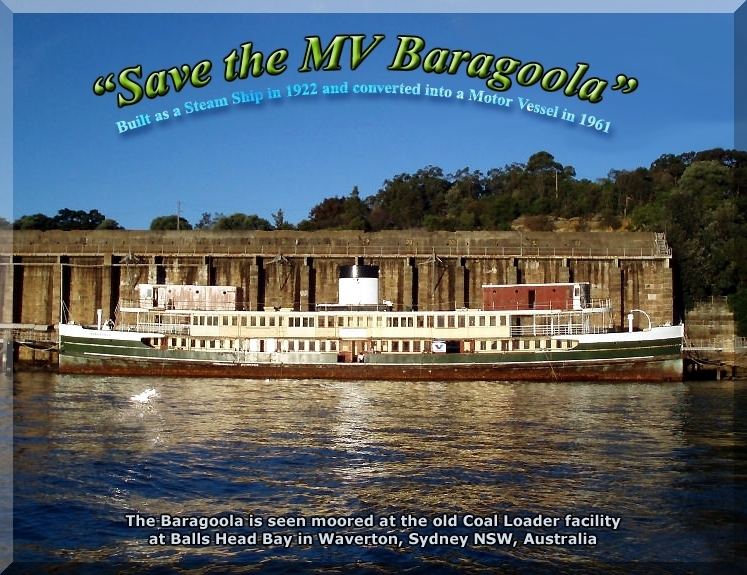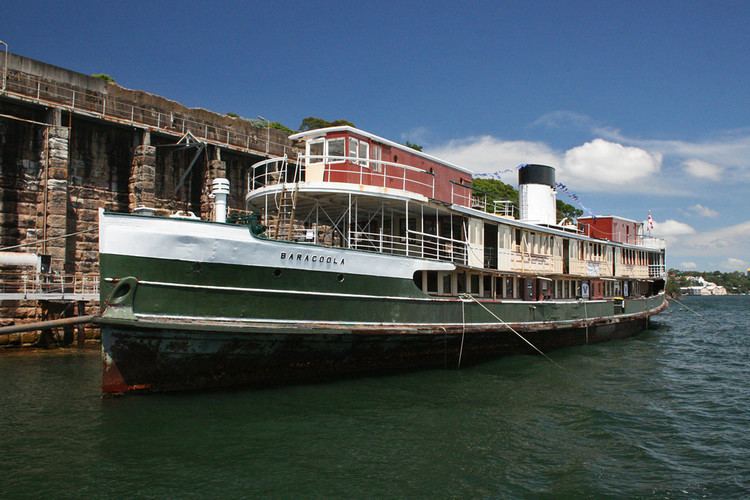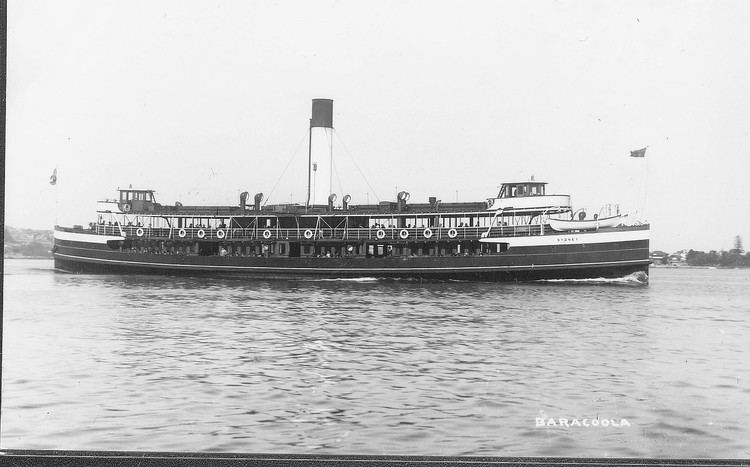Port of registry Sydney Cost £72,000 Length 61 m Draft 3.75 m Capacity 1,523 | Route Manly Launched 14 February 1922 Tonnage 498,000 kg Beam 10 m Builder Mort's Dock | |
 | ||
Name MV Baragoola
formerly SS Baragoola Owner Baragoola Preservation Association Incorporated Operator Port Jackson & Manly Steamship Company
Public Transport Commission
Urban Transit Authority | ||
The MV Baragoola (formerly the SS Baragoola) is a ferry operated by the Port Jackson & Manly Steamship Company and its successors on the Manly service from 1922 until 1983.
Contents

History

Baragoola was built by Mort's Dock, Balmain for the Port Jackson & Manly Steamship Company. Launched in 1922, it was the sixth and final Binngarra type vessel.

Baragoola had was involved with a number of collisions while in service. The first occurred on Christmas Eve 1926 off Kirribilli Point when she collided with the Sydney Ferries Limited's Kosciusko. On 12 September 1927 Baragoola ran down a lifeboat from the French steamer Ville D'Amiens, five people were thrown out of the lifeboat, one of whom was later hospitalised. The people were rescued by two fishing trawlers in the vicinity and the lifeboat was severely damaged. On 28 August 1934 Baragoola struck and killed a whale. The event garnered media interest when the disposal of the corpse took nine days and multiple attempts.

Like her sisters, Bellubera and Barrenjoey, she was modified in the early 1930s with a closed upper deck, thus improving passenger amenities. She was also subject to an experiment at the same time where she was modified to run on pulverised coal; this was stopped when it was discovered that the vessel and passengers were being showered in coal dust.

She was then the first of the fleet to be modified to burn bunker oil and coal tar; between 8 March and 3 August 1939 Baragoola was altered to an oil burner using tar under natural draught, like the Curl Curl, Dee Why and South Steyne. Propellers of improved design were also fitted at this time. Other modifications included in 1948 the removal of her chain operated steering gear that were replaced with Brown Brothers (later known as Vickers) hydraulic equipment. In 1958, it was withdrawn for a rebuild by which included the replacement of its steam engines with English Electric 7SKM diesel-electric engines. It returned to service in 1961.

Baragoola was included in the sale of the business to Brambles in April 1972, and again to the Public Transport Commission in December 1974. Following the delivery of the Freshwater, Baragoola was withdrawn on 8 January 1983 gaining significant media coverage.
She was sold to Bob Hyde for use as a floating university, an enterprise that never took off and following which she was laid up at Rozelle Bay until 1988 when she was again sold, this time to David Ashton of Waterview Wharf, Balmain. In late 2003, she was evicted from Waterview Wharf and relocated to the Coal Loader in Balls Head Bay where it remains today.
In 2009, following a period of animosity from NSW Maritime, Ashton offered the vessel for sale by auction and she passed into ownership of Adrian Thompson, who considered scrapping the vessel. In March 2010, Baragoola was sold to the Baragoola Preservation Association, a not for profit organisation who have undertaken the task of restoring the vessel.
The restoration has not been without incident when a training activity by the Australian Army, utilising Black Hawk helicopters caused damage to the vessel's upper works on 1 December 2010. The Army was conducting a training exercise involving the ex Commonwealth Lighthouse tender Cape Don moored next to Baragoola. The vessel is listed on the Australian Register of Historic Vessels
Internal layout
Typical of all Manly ferries constructed until 1938, Baragoola's public spaces are laid out to a specific format. On the lower deck, aft, there is a segregated Ladies Salon with toilets, a Main Cabin and forward is the Smoking Saloon (usually reserved for men) with toilets. This area also contains the original Mail Room and was the site of the Crew's Mess. The upper deck is completely open. The internal hull arrangement has two void spaces at either end, a hold immediately aft of the forward void, the engine room behind the hold connected to the control room and (second from the aft) a compartment that contains batteries, auxiliary diesel tank, fresh water tank and the Engineer's Quarters.
Motive power
As a steamer, Baragoola was powered by a three-cylinder triple expansion steam engine with characteristics of 18", 28", 47.5" and 27" cylinders developing 1,300 ihp (970 kW). She had two marine horizontal multitubular (navy type) boilers. She was fitted with electro hydraulic steering equipment after World War 2 which replaced her earlier chain steering.
After conversion to diesel her motive power was four English Electric 7SKM diesels generating 600 bhp (450 kW) at 600rpm. These engines are the only remaining operational ones of their type, having only ever been installed in three Manly ferries.
